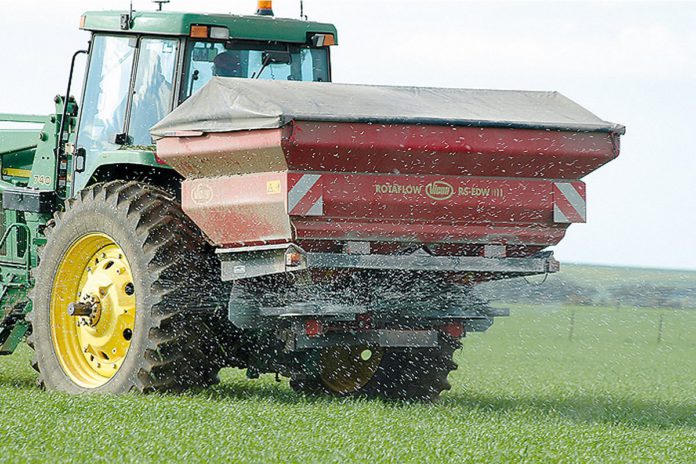Austin Callaghan, drystock advisor at Teagasc Claremorris, discusses when to spread fertiliser and slurry, LESS and slurry application rates.
In most years, the best response to fertiliser is when grass growth is at its peak from April onwards. Fertiliser applications should coincide with this.
Spread fertiliser from mid-March onwards, fertilising silage fields in early April. On colder, heavier soils spread two weeks later.
Slurry application
Slurry is a valuable source of nitrogen. These applications should also coincide with the onset of good grass growth. Ideally, apply slurry from March onwards.
Each 1000 gallons can supply 9 units of nitrogen. An application of 3000 gallons can provide 27 units of nitrogen, equivalent to a bag of CAN.
Slurry spread in late January will not provide these units. Why waste this valuable nutrient? Slurry is also a very good source of P & K, and for this reason, slurry should be spread on silage fields before closing.
Low Emission Slurry Spreading
Slurry spread in very warm dry weather conditions loses nitrogen to the atmosphere. For this reason, you should use low emission slurry spreading (LESS) equipment to spread slurry.
This will increase the nitrogen recovered from the slurry compared to the traditional splash plate.
Slurry application rate
Take care when using the dribble bar or the trailing shoe not to apply this slurry at a high application rate.
Forward speed of the tractor needs to be increased when using this equipment as we have come across cases where slurry has been applied at over 4000 gallons per acre. This can have implications later for silage preservation.
Lime
Where soils are acidic, chemical fertilisers or organic fertilisers (slurry / FYM) will not function to their maximum.
The response to the nutrients applied will be reduced. In addition, acidic soils reduce the availability of many of the essential nutrients as they are bound to clay particles in the acidic soil.
Also, the breakdown of organic matter (decaying grass / grass roots / slurry) is reduced in acidic soils.
Soil type
The response to all applied fertilisers is much lower on poor soils, peat soils or heavy poorly drained soils.
Only apply fertiliser to these fields in very good weather conditions. In the situation where the farm has a low stocking rate, consider not fertilising these fields in 2022.
Stocking rate
On most enterprises, farmers apply fertiliser to silage fields. In 2022, on lowly stocked farms, consider not fertilising the grazing fields.
To ensure adequate supplies of winter fodder silage fields need to receive appropriate fertiliser applications. Chemical nitrogen applications can be reduced where slurry is applied as described above.
Paddocks / rotational grazing
If farmers put a rotational paddock system in place, their farm will grow more grass without any additional fertiliser inputs.
Ask any farmer who has put a paddock system in place, and the problem they have is they have too much grass. In this scenario, where grass growth exceeds demand, you could cut some fields for silage.
There is no denying the high fertiliser prices will provide a huge challenge in 2022. There is scope to reduce the impact if you plan now.
The response of some farmers is to immediately cut stock numbers. This may not be a good solution as farm output will be reduced.
Farms with low output have great difficulty generating positive net margins.
Other articles:





